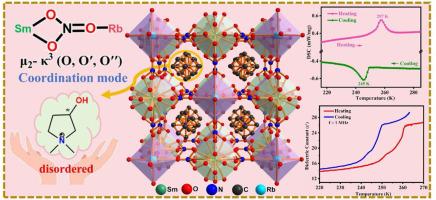Reversible phase transition, dielectric and fluorescent properties of chiral 3D double perovskites
IF 4.7
2区 化学
Q2 CHEMISTRY, PHYSICAL
引用次数: 0
Abstract
Organic-inorganic hybrid rare-earth double perovskite materials, as a novel multifunctional material system, have demonstrated broad application prospects in ferroelectrics, ferroelastics, piezoelectrics, ferromagnetics, superconductivity, and optoelectronic devices due to their unique organic-inorganic synergistic effects and the 4f electronic characteristics of rare-earth ions. However, current research predominantly focuses on non-chiral systems, while the integration of chiral organic amines with three-dimensional bimetallic perovskite frameworks remains less explored. In this study, based on a molecular engineering strategy, we successfully synthesized two novel chiral hybrid double perovskite compounds [R-3-HDMP]2RbSm(NO3)6 (1) and [S-3-HDMP]2RbSm(NO3)6 (2) (3-HDMP = hydroxy‑N,N-dimethylpyrrolidinium) through precise modification of azacyclic amine skeletons with chiral hydroxyl groups, followed by self-assembly with alkali metal salts and rare-earth metal salts in a 2:1:1 stoichiometric ratio. The enantiomeric configurations of both compounds were demonstrated through vibrational circular dichroism (VCD) spectroscopy. The structures of the compounds were characterized by the variable temperature X-ray single-crystal diffractometer. A differential scanning calorimeter was used to reveal the significant reversible phase transition behavior of 1 and 2 near 251 K/239 K. Meanwhile, the dielectric constant was evaluated to show that stepwise dielectric anomalies occurred near the phase transition temperature. In addition, the fluorescence spectra revealed the characteristic emission behavior of Sm3⁺. Obvious peaks were observed at 564 nm (corresponding to the 4G5/2 → 6H5/2 transition), 597 nm (corresponding to the 4G5/2 → 6H7/2 transition) and 646 nm (corresponding to the 4G5/2 → 6H9/2 transition), confirming that the energy level structure of rare earth ions in the hybrid system was well preserved. This study not only expands the material library of chiral hybrid perovskites but also provides new ideas for the collaborative design of multiferroic materials and optoelectronic functional materials.

手性三维双钙钛矿的可逆相变、介电和荧光性质
有机-无机杂化稀土双钙钛矿材料作为一种新型的多功能材料体系,由于其独特的有机-无机协同效应和稀土离子的4f电子特性,在铁电、铁弹性、压电、铁磁、超导、光电器件等方面具有广阔的应用前景。然而,目前的研究主要集中在非手性体系,而手性有机胺与三维双金属钙钛矿框架的整合仍然较少探索。本研究基于分子工程策略,通过手性羟基对氮杂环胺骨架进行精确修饰,并与碱金属盐和稀土金属盐按2:1:1的化学计量比自组装,成功合成了两种新型手性杂化双钙钛矿化合物[R-3-HDMP]2RbSm(NO3)6(1)和[S-3-HDMP]2RbSm(NO3)6 (2) (3-HDMP =羟基N,N-二甲基吡啶)。两种化合物的对映体构型通过振动圆二色性(VCD)光谱进行了表征。用变温x射线单晶衍射仪对化合物的结构进行了表征。差示扫描量热计揭示了1和2在251 K/239 K附近明显的可逆相变行为。同时,对介电常数进行了计算,结果表明介电异常在相变温度附近呈阶梯状分布。此外,荧光光谱显示了Sm3⁺的特征发射行为。在564 nm处(对应4G5/2→6H5/2跃迁)、597 nm处(对应4G5/2→6H7/2跃迁)和646 nm处(对应4G5/2→6H9/2跃迁)观察到明显的峰,证实了稀土离子在杂化体系中的能级结构得到了较好的保存。本研究不仅扩充了手性杂化钙钛矿的材料库,而且为多铁性材料和光电子功能材料的协同设计提供了新的思路。
本文章由计算机程序翻译,如有差异,请以英文原文为准。
求助全文
约1分钟内获得全文
求助全文
来源期刊

Journal of Molecular Structure
化学-物理化学
CiteScore
7.10
自引率
15.80%
发文量
2384
审稿时长
45 days
期刊介绍:
The Journal of Molecular Structure is dedicated to the publication of full-length articles and review papers, providing important new structural information on all types of chemical species including:
• Stable and unstable molecules in all types of environments (vapour, molecular beam, liquid, solution, liquid crystal, solid state, matrix-isolated, surface-absorbed etc.)
• Chemical intermediates
• Molecules in excited states
• Biological molecules
• Polymers.
The methods used may include any combination of spectroscopic and non-spectroscopic techniques, for example:
• Infrared spectroscopy (mid, far, near)
• Raman spectroscopy and non-linear Raman methods (CARS, etc.)
• Electronic absorption spectroscopy
• Optical rotatory dispersion and circular dichroism
• Fluorescence and phosphorescence techniques
• Electron spectroscopies (PES, XPS), EXAFS, etc.
• Microwave spectroscopy
• Electron diffraction
• NMR and ESR spectroscopies
• Mössbauer spectroscopy
• X-ray crystallography
• Charge Density Analyses
• Computational Studies (supplementing experimental methods)
We encourage publications combining theoretical and experimental approaches. The structural insights gained by the studies should be correlated with the properties, activity and/ or reactivity of the molecule under investigation and the relevance of this molecule and its implications should be discussed.
 求助内容:
求助内容: 应助结果提醒方式:
应助结果提醒方式:


